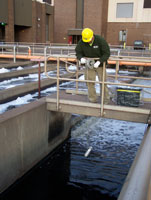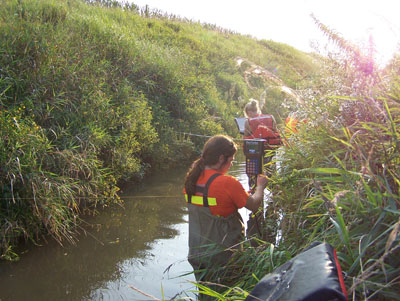
Endocrine Active Chemicals/Wastewater Treatment Plant
Minnesota PROJECTS
ABOUT THE MINNESOTA
WSC
USGS IN YOUR STATE
USGS Water Science Centers are located in each state.

|
Relative contributions of selected endocrine active chemicals and pharmaceuticals from wastewater treatment plant effluent and other sources to Minnesota surface waters – Implications for aquatic communities
A joint project among the U.S. Geological Survey, Minnesota Pollution Control Agency, St. Cloud State University, University of St. Thomas, St. Paul, MN, and the University of Colorado, Boulder, CO.
SUMMARY

Information on the concentrations EACs and pharmaceuticals in water and bottom sediments are needed to determine relative contributions of contaminants from WWTP effluent and upstream sources and to estimate potential organism exposure. The USGS and the MPCA in collaboration with SCSU, UST, and the University of Colorado collaborated on this study to determine the relative contributions of EACs and pharmaceuticals in water samples collected from the effluents from 25 WWTPs and at sites upstream and downstream of WWTP effluent discharge in Minnesota during September-November 2009. The second objective is to measure concentrations of EACs and pharmaceuticals in bottom sediments collected upstream and downstream of effluent discharges, and the third objective is to estimate estrogenicty of water samples using an in-vitro bioassay, and concentrations of plasma vitellogenin and other sex characteristics of caged fish from onsite exposure experiments. This study provides information to local, state, and federal agencies that manage water resources needed to evaluate potential effects of EACs and pharmaceuticals on aquatic organisms and the relative contributions of these contaminants from WWTP effluent.
Project News
More about the project
Publications
- Occurrence of triclosan, triclocarban, and its lesser chlorinated congeners in Minnesota freshwater sediments collected near wastewater treatment plants
- Endocrine Active Chemicals, Pharmaceuticals, and Other Chemicals of Concern in Surface Water, Wastewater-Treatment Plant Effluent, and Bed Sediment, and Biological Characteristics in Selected Streams, Minnesota-Design, Methods, and Data, 2009
|

